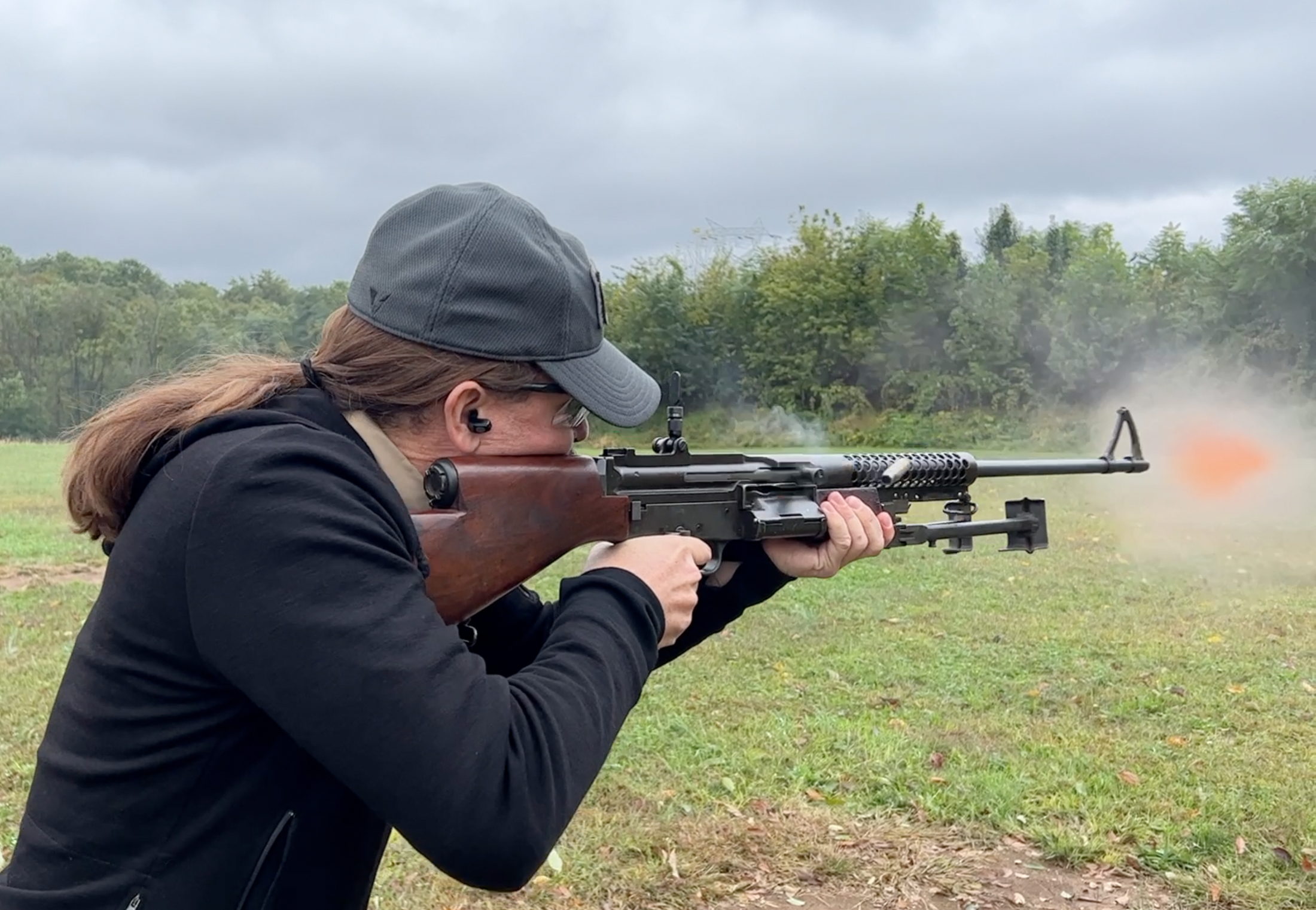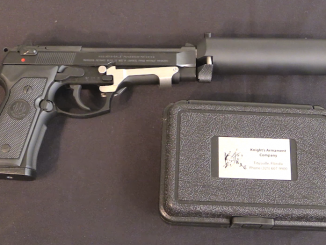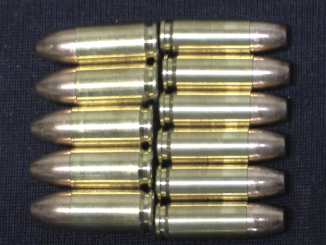The Mk18 Mod0 grenade launchers was developed by the Honeywell corporation in 1962, and was the first weapon in what would became a category of high volume grenade launchers used by the US military. The modern iterations are all self-loading, but this first example was fired by a manual crank handle, like a Gatling gun. The Mk18 used the same 40x46mm grenade cartridge as the single shot M79 launcher, and this round’s low pressure allowed the Mk18 to use a rather unusual breech mechanism.
Unlike most belt-fed weapons, the cartridges in the Mk18 never left the belt. Instead, the breech consisted of two rotating spindles which would form the top and bottom halves of the chamber, closing around each shell as the handle was cranked. As a result, a loaded belt of grenades fed into the weapon, and a belt of empty cases came out the other side. Another effect of the low pressure cartridge was a rather short effective range, which limited adopted of the weapon to the US Navy, which bought 1200 and used them primarily on riverine patrol boats. In this application, the short effective range was not much of a hindrance, and the volume of high explosive firepower was a significant asset.
Armament Research Services (ARES) is a specialist technical intelligence consultancy, offering expertise and analysis to a range of government and non-government entities in the arms and munitions field. For detailed photos of this very cool early grenade launcher, don’t miss the ARES companion blog post.




A Mk18! Always a favorite, but how delightfully unexpected.
I suppose this could also substitute for a mortar if some indirect fire sighting equipment was attached. The other team does not appreciate grenade spam coming from behind the bushes. This won’t qualify as a machine gun since it operates by manual effort. But it might be considered a destructive device by rules.
Any opinions on crank-fire triggers for semi-automatic rifles? I hope they can’t be used for massacres… but then again the previous media spat over bump-fire stocks left me crying tears of laughter. We have no shortage of idiots who can’t tell the difference between a fancy “range toy” and a Browning M1918. Getting away from politics, just how many times did gunboats need a rapid fire salvo of explosives to deal with unfriendly people on the riverbank?
It’s a DD from being 40mm, plus each explosive round is also a DD because explosives. So slightly easier to own than a machine gun (no registry issues), but good luck feeding it.
Too short range to be a substitute for a mortar.
But it qualify as a mechanical machine gun like a Gatling, a Nordenfeld or a Gardner.
Even with the 40x46mm, you can do some indirect-fire work, but I only saw it for the M79, not the Mk18 or XM148. It’d be sort of like the WWII Japanese 50mm Type 89 grenade discharger (“knee mortar”), or a hand-held 50mm or 60mm mortar. The mod that I saw documentation for involved putting tape marks on the sling at specific distances below the front sling swivel and mark them for their associated ranges, and may have involved setting the sling to a particular length. Eyeball the line, brace the toe of the recoiil pad on the ground, put your foot on the (for example) 250m mark on the sling, pull the sling up taught and in theory, you’re dropping a round on “their” heads at 250m. I wasn’t using a a ’79 much and never got a chance to try it, just saw the TM update insert.
To put a little perspective on 40mm grenades, the low velocity one are 180 grams starting at 76 meters by second for a 400 meters range. The high velocity are 240 grams at 240 meters by second for a 2200 meters range.
The HV have roughly 4 times the recoil impulse and 18 times the recoil energy of the LV! You see why HV are not fired from the shoulder.
There exists some OF Extended Range (180 grams at 100 meters by second for 600 meters range) and some Medium Velocity (240 grams at 100 meters by second for 800 meters range) but they are no fun to shoot from a stand alone launcher. And no more from an under barrel launcher even with the added weight of the host weapon. These beast are hard on men and weapons.
“180 grams starting at 76 meters by second for a 400 meters range. The high velocity are 240 grams at 240 meters by second for a 2200 meters range.”
For comparison Soviet AGS-17: http://gunrf.ru/rg_granatomet_ags-17_eng.html
has muzzle velocity of 185 m/s
“The high velocity are 240 grams at 240 meters by second for a 2200 meters range.”
Russian АГС-40 «Балкан»
http://oruzhie.info/granatomety/850-ags-40-balkan
created with outperforming AGS-17 in mind, uses peculiar caseless 40 mm grenades (see photos) and has range 2500 m
“Mk18 to use a rather unusual breech mechanism.”
It seems to be somewhat similar to Great War-era Fokker-Leimberger aviation machine gun: https://en.wikipedia.org/wiki/Fokker-Leimberger
I am wondering does designer of Mk18 were aware of this machine gun?
It also seems to resemble the Dardick “tround” revolver breech;
https://vignette.wikia.nocookie.net/guns/images/3/39/D1100.jpg/revision/latest?cb=20150514124255
And to a certain extent, the Civil War Ball repeating carbine breech;
https://www.forgottenweapons.com/lamson-ball-carbine-henry-meets-spencer-sort-of/
Both had what you could call “split” chambers that closed around the cartridge from “top” and “bottom”, rather than feeding from the rear in the more usual fashion.
It’s really only practical with relatively low-pressure ammunition and a relatively strong cartridge case. Since the 40mm M79 ammunition worked on the “High-Low pressure” system developed by Rheinmetall-Borsig for the 8 cm Panzer Abwehr Werfer 600 in 1944;
https://en.wikipedia.org/wiki/8_cm_PAW_600
https://en.wikipedia.org/wiki/High%E2%80%93low_system
Most of its firing pressure was contained by the cartridge case itself, not the breech. So it would be just the sort of round that would make perfect sense in a system like this.
cheers
eon
Best use of this puppy had to do with educational knowledge of the well known phenome of “barricks-bullshit.“ (Misspelling intentional and well deserved.)
In other words, don’t believe everything you hear in a pre-“lights-out” conversation from the platoon cook regarding 40mm rounds and what they work with.
A Huey 40mm won’t fit in a M79, no matter how hard you hammer it nor what the platoon cook tells you..thank god.
Lucky you.
VERY lucky you.
A USN MK 19 round won’t fit a 79 or a 203, either, and you absolutely don’t want it to.
cheers
eon
If it did you’d be blown to Kingdom Come. And your intended victims would die laughing.
I’d love to see an XM174.
I am glad to see introduction into grenade-launchers (those non related to rifles) – they are very effective and exist in great variety. It looks to me that Russians also in this category eclipsed the West. Chinese are not idle either and created line of their own; some models were used successfully in Syria.
Several of the Russian and Chinese models are 30mm, and fire a muzzle-loaded caseless round. Interestingly, a similar setup was devised by the Japanese in WW2 for a 40mm aircraft cannon;
https://en.wikipedia.org/wiki/Ho-301_cannon
It occurs to me that if they had developed it as a ground weapon,it would have been a nasty surprise for our troops. 150 meters range isn’t much by air combat standards, but it would have nicely filled the gap between maximum rifle-grenade ranges and minimum mortar ranges. Add in automatic fire capability, and it would have made a very effective “area denial” weapon for the defense of a pillbox complex.
cheers
eon
Combination of case-less (or better said ‘shell integrated case’) and breech loading would be great; it is all about effective breech seal – as always with case-less.
“Combination of case-less (or better said ‘shell integrated case’) and breech loading would be great;”
Balkan grenade launcher use case-less (sort of) ammunition and is breech loaded:
http://modernfirearms.net/en/grenade-launchers/russia-grenade-launchers/balkan-eng/
See 5th image from top: “case” go out together with projectile, thus it is more or less similar to Benelli CB M2.
I looked at previous source you provided. My impression: phenomenal, although as this resembles taking off of small rockets, there is lots of open flash around feeding area. This may be liability in terms of indicating weapon position in low light.
If a platoon suddenly came under fire from such a defense setup in such a manner that the platoon could not get support quickly after getting pinned down, I imagine this problem:
“Oh fiddlesticks! An automatic mortar pillbox!? Where’s our armor support when we need it?!”
“They can’t get into the valley because of those stupid huge rocks someone rolled into the road!”
“Where’s our artillery?!”
“You want us to buy the farm too?! They can’t target what they can’t see on a [bleeping] map!”
“Then get a bazooka, you nit-wit!!”
“You want me to get sniped?!”
“That pillbox can’t snipe what it can’t see!” Flank it, you moron!”
Did I mess up the argument?
“Russians also in this category eclipsed the West”
Ok, but we must start from beginning, so let go into… 1930s.
First production automatic grenade launcher of Soviet Union was Taubin Grenade Launcher: http://zonwar.ru/granatomet/stankovie/Taubin.html
warhead were same as Dyakonov grenade (used with Mosin rifle), but propellant was added to it.
It was produced in limited number and tested with favorable but fail to enter wide-scale production due to win of group-of-interest which might be called “mortar-men”
Basic data:
Caliber: 40,8 mm
Mass, ready-to-combat: 45,5 kg
Grenade [projectile] mass: 0,59 kg
Maximal range: 1250 m
Rate-Of-Fire (cyclic): 436 rpm
Rate-Of-Fire, practical: 57 rpm
Fast forward to 1968, development start which will end in AGS-17
http://zonwar.ru/granatomet/stankovie/AGS-17.html
Widely used during intervention in Afghanistan, ballistic-wise somewhat weaker than U.S. grenade launcher, but also lighter.
Basic data:
Round: 30x29B
Length: 840 mm
Weight of body: 18 kg
Weight of 6Т8 tripod: 12 kg
Rate-Of-Fire: 350-400 rpm
Effective range of fire (single targets): up to 800 m
Maximal range: 1700 m
Now to 1990s:
AGS-17 proved good, but maybe lighter mass is possible, AGS-30 is created:
http://zonwar.ru/granatomet/stankovie/AGS-30.html
this weapon complete with tripod mass is 16 kg, use same ammunition as AGS-17, fire 400 rpm.
It is often found mounted on various vehicles.
Some other lateral branch of automatic grenade launcher development:
«Арбалет»:
http://zonwar.ru/granatomet/ru4nie/Arbalet.html
Also known as ТКБ-0249 it was constructed in 1998, use same ammunition as AGS-17 and AGS-30, it could use 5 or 10 capacity magazine, it is 900 mm and its mass is 10 kg, yet thanks to amortizing system it can be fired like LMG.
And finally GM-94 of 43 mm caliber:
https://en.wikipedia.org/wiki/GM-94
it is pump-action (sort of) with tubular magazine above barrel.
Which can use wide range of more and less special projectiles, HE, rubber, gas-irritant and even high-explosive shards-less (фугасные безосколочные) which is fancy name for thermobaric.
Some explanation about thermobaric: such warhead used blastwave instead of fragmentation to do damage. For thermobaric round for GM-94 radius of damage is said to be 3 m, when safety radius 5 m.
I don’t have detailed data for that one, but it also used in various rocket system, for example 9М55С rocket for Смерч generate radius of damage not less than 25 m, temperature over 1000 degrees C lasting no less than 1,4 second
https://ru.wikipedia.org/wiki/Смерч_(РСЗО)
Thank you for all the detailed information. I have read much of it in past and refreshment comes in to good use. I consider AGS-17/30 to be excellent weapons, namely for their mobility. In comparison, most common U.S. weapon in that category being the Mk19, as capable as it is with its reach out to 2.2km, is so heavy it can be practically used only mounted on vehicles.
The HK automatic grenade launcher is presumably more developed, but still too heavy to be moved by foot soldier.
https://en.wikipedia.org/wiki/Heckler_%26_Koch_GMG
“I consider AGS-17/30 to be excellent weapons, namely for their mobility.”
I forgot to add that AGS-30 was designed under leadership of Gryazev (that G in GSh- of aviation autocannons)
The HK GMG is heavy, but “only” in the same class as old water-cooled Maxim machine guns. So, it can be carried by foot soldiers if necessary. The ammunition is a different matter and carrying substantial numbers of rounds would be prohibitive. More important is that it can be transported in a light vehicle and relatively quickly deployed to a position by the crew, which would be more difficult with the heavier Mk 19.
There is also the new Mk 47, which is much lighter than previous 40mm AGLs:
https://www.gd-ots.com/armaments/individual-crew-served-weapons/mk47-mod-0-40mm-advanced-grenade-launcher/
I’d have thought a gadget like this would be used to defend prepared positions. Preset to shower grenades over the perimeter.
Just the thing to use while extracting a SEAL team in the Delta, trying to get them on board your PBR under VC fire. While they broke contact with their Stoners, you could lay covering grenades over their heads with this. Since the other possible grenade launcher available to boat crewmen and SEALs was an M79, this would have much greater rate of fire, even if hand cranked. it looked like this uses the same rounds as an M79 as well.
Remotely related, not exactly ground application system, but anyway…
https://www.youtube.com/watch?v=cZCuI_xtKUM
Some time back I spoke with ex-South African Mirage pilot who lost his friend to the previous version. He had word of respect for it and specifically pointed out radar. I wonder, if there is potential radar use for ground based system such as automatic grenade launcher.